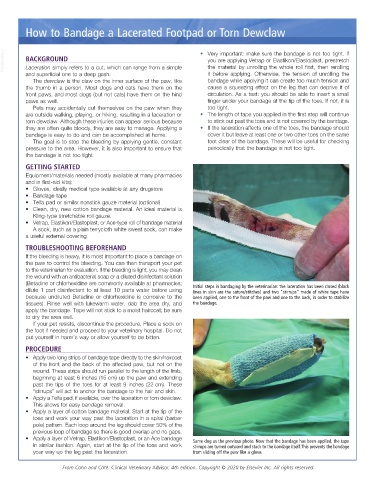Page 3168 - Cote clinical veterinary advisor dogs and cats 4th
P. 3168
How to Bandage a Lacerated Footpad or Torn Dewclaw
VetBooks.ir BACKGROUND • Very important: make sure the bandage is not too tight. If
you are applying Vetrap or Elastikon/Elastoplast, prestretch
the material by unrolling the whole roll first, then rerolling
Laceration simply refers to a cut, which can range from a simple
and superficial one to a deep gash. it before applying. Otherwise, the tension of unrolling the
The dewclaw is the claw on the inner surface of the paw, like bandage while applying it can create too much tension and
the thumb in a person. Most dogs and cats have them on the cause a squeezing effect on the leg that can deprive it of
front paws, and most dogs (but not cats) have them on the hind circulation. As a test: you should be able to insert a small
paws as well. finger under your bandage at the tip of the toes. If not, it is
Pets may accidentally cut themselves on the paw when they too tight.
are outside walking, playing, or hiking, resulting in a laceration or • The length of tape you applied in the first step will continue
torn dewclaw. Although these injuries can appear serious because to stick out past the toes and is not covered by the bandage.
they are often quite bloody, they are easy to manage. Applying a • If the laceration affects one of the toes, the bandage should
bandage is easy to do and can be accomplished at home. cover it but leave at least one or two other toes on the same
The goal is to stop the bleeding by applying gentle, constant foot clear of the bandage. These will be useful for checking
pressure to the area. However, it is also important to ensure that periodically that the bandage is not too tight.
the bandage is not too tight.
GETTING STARTED
Equipment/materials needed (mostly available at many pharmacies
and in first-aid kits):
• Gloves, ideally medical type available at any drugstore
• Bandage tape
• Telfa pad or similar nonstick gauze material (optional)
• Clean, dry, new cotton bandage material. An ideal material is
Kling-type stretchable roll gauze.
• Vetrap, Elastikon/Elastoplast, or Ace-type roll of bandage material
A sock, such as a plain terrycloth white sweat sock, can make
a useful external covering.
TROUBLESHOOTING BEFOREHAND
If the bleeding is heavy, it is most important to place a bandage on
the paw to control the bleeding. You can then transport your pet
to the veterinarian for evaluation. If the bleeding is light, you may clean
the wound with an antibacterial soap or a diluted disinfectant solution
(Betadine or chlorhexidine are commonly available at pharmacies;
dilute 1 part disinfectant to at least 10 parts water before using Initial steps in bandaging by the veterinarian: the laceration has been closed (black
lines in skin are the suture/stitches) and two “stirrups” made of white tape have
because undiluted Betadine or chlorhexidine is corrosive to the been applied, one to the front of the paw and one to the back, in order to stabilize
tissues). Rinse well with lukewarm water, dab the area dry, and the bandage.
apply the bandage. Tape will not stick to a moist haircoat; be sure
to dry the area well.
If your pet resists, discontinue the procedure. Place a sock on
the foot if needed and proceed to your veterinary hospital. Do not
put yourself in harm’s way or allow yourself to be bitten.
PROCEDURE
• Apply two long strips of bandage tape directly to the skin/haircoat
of the front and the back of the affected paw, but not on the
wound. These strips should run parallel to the length of the limb,
beginning at least 6 inches (15 cm) up the paw and extending
past the tips of the toes for at least 9 inches (22 cm). These
“stirrups” will act to anchor the bandage to the hair and skin.
• Apply a Telfa pad, if available, over the laceration or torn dewclaw.
This allows for easy bandage removal.
• Apply a layer of cotton bandage material. Start at the tip of the
toes and work your way past the laceration in a spiral (barber
pole) pattern. Each loop around the leg should cover 50% of the
previous loop of bandage so there is good overlap and no gaps.
• Apply a layer of Vetrap, Elastikon/Elastoplast, or an Ace bandage
in similar fashion. Again, start at the tip of the toes and work Same dog as the previous photo. Now that the bandage has been applied, the tape
stirrups are turned outward and stuck to the bandage itself. This prevents the bandage
your way up the leg past the laceration. from sliding off the paw like a glove.
From Cohn and Côté: Clinical Veterinary Advisor, 4th edition. Copyright © 2020 by Elsevier Inc. All rights reserved.

